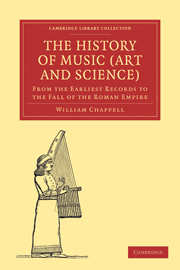Summary
And now, as to Instruments of Percussion.
Among these, the Sistrum has some claim to be first named, on account of its having been employed in Egyptian temples, and for religious purposes exclusively. It consisted of a thin oval hoop of metal, fixed at the lower end into a handle, and the handle was usually of metal also. The hoop was pierced with holes at equal distances on both sides, and in these holes were three or four loose metal bars, which were all to be shaken at one time, by a light jerk from the hand, and this made them rattle. The bars were like the stems of thin fire-pokers, but they were bent at the ends, to prevent their falling out of their places. “It was so great a privilege,” says Sir J. Gardner Wilkinson, “to hold the sacred Sistrum in the temple, that it was given to queens, and to those noble ladies who had the distinguished title of ‘women of Amun’ and who were devoted to the service of the deity.” The Egyptian Amun was the Jupiter Ammon of the Romans. Again, Sir Gardner says, “The Sistrum was the sacred instrument par excellence, and belonged as peculiarly to the service of the temple, as the small tinkling bell to that of the Eoman Catholic chapel. Some pretend it was used to frighten away Typhon,” [the Evil Being,] “and the rattling noise of its movable bars was sometimes increased by the addition of several loose rings. It had generally three, rarely four, bars; and the whole instrument was from eight to sixteen or eighteen inches in length, entirely of brass or bronze.
- Type
- Chapter
- Information
- The History of Music (Art and Science)From the Earliest Records to the Fall of the Roman Empire, pp. 286 - 294Publisher: Cambridge University PressPrint publication year: 2009First published in: 1874

